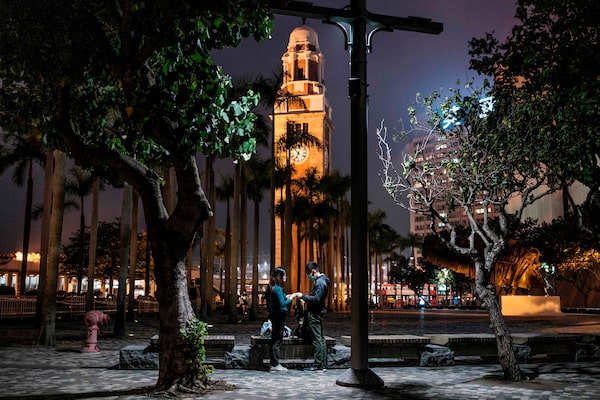Niall Ferguson is the Milbank Family senior fellow at the Hoover Institution, Stanford, and managing director of Greenmantle

A man and a woman wear face masks as a precautionary measure against COVID-19 as they chat in front of the Tsim Sha Tsui Clock Tower in the Kowloon district of Hong Kong on March 13, 2020. The world economy looks dead. Can it be resurrected? writes Niall FergusonANTHONY WALLACE/AFP/Getty Images
Easter never felt more Eastery. The world economy looks dead. Can it be resurrected?
Just over a century ago, amid the worst influenza pandemic in history, the greatest economist of his generation fell ill. John Maynard Keynes was in Paris, attending the peace conference that would ultimately produce the Treaty of Versailles.
He remained prostrate for close to a week. Did Keynes have the dreaded Spanish flu? If so, he was lucky to survive it. According to the latest estimate, that pandemic killed 39 million people – 2 per cent of the world’s population – dwarfing the battlefield fatalities of the First World War.
Shortly after his recovery and return to Britain, Keynes wrote the inflammatory tract that made him famous, the Economic Consequences of the Peace. In it, he deplored the punitive terms of the Versailles treaty – which imposed on Germany an unspecified but potentially vast war reparations debt – and prophesied an inflationary economic disaster, followed by a political backlash.
Who among today’s great economists will write the Economic Consequences of the Plague? Large parts of the world’s economy have been brought to an abrupt standstill by the COVID-19 pandemic. To contain the contagion, countless businesses have been told to cease trading and millions of workers have been told to stay at home. To offset this “supply shock”, and to prevent a catastrophic downward spiral of shrinking demand and debt deflation, the world’s central banks and finance ministries are injecting even more “liquidity” – that’s money, to you and me – than they did in the wake of the 2008-9 financial crisis.
I feel a bit like Keynes did in 1919. Of course, I see the need to get money to those workers who will likely be unemployed for as long as it takes the scientists and pharmaceutical companies to find and distribute a COVID-19 vaccine. But the Fed’s current policy would appear to be a generalized bailout of investors, even those whose positions were known to be risky.
And the U.S. Congress has, in great haste and amid frantic horse-trading, passed legislation that commits taxpayers to write down hundreds of billions of dollars of “loans” to businesses large and small.
Moreover, the legislation would appear to make more than half of American workers better off being unemployed than they would have been working.
Turning to some of today’s leading economists, Kenneth Rogoff – one of Harvard’s few conservative professors – wrote last week of an “economic catastrophe . . . likely to rival or exceed that of any recession in the last 150 years”. The pandemic, Mr. Rogoff argued, was akin to an “alien invasion”.
Larry Summers, who lies somewhere between those two ideologically, chose a more grisly metaphor in an interview on Thursday. “Physical isolation is chemotherapy,” he said, “and the goal is remission. The problem is that chemo is . . . increasingly toxic over time.” He foresees an “accordion-like dynamic” until a vaccine is generally available in 12 to 18 months.
I am with Mr. Rogoff and Mr. Summers. This is a disaster, the economic consequences of which cannot be offset by even the biggest monetary and fiscal splurge.
Our estimates at my macroeconomic and geopolitical advisory firm Greenmantle, based on state-by-state assessments that allow for the share of the population who can work from home, suggest a slight drop in GDP for the first quarter of this year (-1.45 per cent quarter on quarter), followed by a lockdown-driven collapse (-10.8 per cent) in the second quarter. We expect a partial rebound of 6.5 per cent in the third quarter, as lockdowns are partially relaxed but social-distancing measures remain in place – as they must, until a vaccine is available.
The key is that in the protracted “post-lockdown, pre-vaccine” period, there will inevitably be a reduction of capacity in all sectors of the economy that depend on some level of social proximity, such as retail, air travel, education, live entertainment, hotels and restaurants.
An economy without crowds is not a new normal. For most people, the word ‘fun’ is almost synonymous with ‘crowd’. The coming year will be a time of depression in the psychological as well as the economic sense.
I can’t honestly wish readers a happy Easter. In the Bible, Christ’s resurrection happens in just three days. The resurrection of the world economy will take a whole lot longer. I only wish Keynes could rise from his eternal rest to tell us exactly how long.
©Niall Ferguson/The Sunday Times, London
Keep your Opinions sharp and informed. Get the Opinion newsletter. Sign up today.